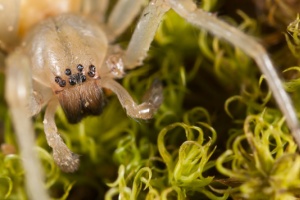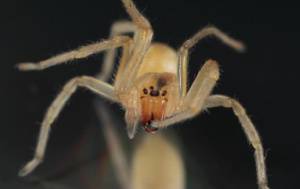The Yellow Sac Spider
 The yellow sac spider is a hunter, chasing prey instead of catching it in webs. They eat insects, other spiders (including larger spider species like hobo spiders), their mates, and sometimes their own eggs.
The yellow sac spider is a hunter, chasing prey instead of catching it in webs. They eat insects, other spiders (including larger spider species like hobo spiders), their mates, and sometimes their own eggs.
Comparatively aggressive, and prevalent, most spider bites come from a yellow sac spider. Females usually lay six sacs of eggs, averaging 37 eggs per batch. They cover these eggs with loose silk.
What do Yellow Sac Spiders Look Like?
 The yellow sac spider is often yellow and can range in color to tan, light brown, and pale green depending on location and diet.
The yellow sac spider is often yellow and can range in color to tan, light brown, and pale green depending on location and diet.
They have a brown stripe down the back of their abdomen over the area where their heart is. They have long, sharp fangs that easily pierce human skin.
Yellow sac spiders are small, ranging from under a quarter-inch to a little less than half an inch.
They have unusually long legs, with the front pair longer than the others. Their legs are covered with stiff black hairs that make them excellent climbers. These hairs are thickest at the bottom, causing them to be known as black feet spiders as well.
Yellow Sac Habitat
Species of the yellow sac spider are common around the world. Two species live throughout the United States, one native and one introduced from Europe. The European yellow sac spider is darker, verging on orange.
During the spring and summer, they prefer to stay outside. Come fall, immature spiders migrate inside. They do not build webs, but spin small sleeping sacks in high, out of the way places. Outside they inhabit foliage on the edge of empty spaces and gardens. Inside they prefer the joint between wall and ceiling, corners, and behind pictures.
Behavior
 Yellow sac spiders stay near their eggs and defend them. They are nocturnal, leaving their sac to hunt at night. They are great climbers and hang out in high places or dark hollows where they feel safe.
Yellow sac spiders stay near their eggs and defend them. They are nocturnal, leaving their sac to hunt at night. They are great climbers and hang out in high places or dark hollows where they feel safe.
Like all spiders, they bite when pressed against the skin. As they love gardens, they are often disrupted and bite threats to their homes. Unlike most spiders, they will bite when startled and have been observed to do so for no reason.
They are rumored to be attracted to car engines and the smell of gasoline. While they are often found inside cars, this is considered most likely due to their numbers and size.
Yellow Sac Spider Bite and Treatment
The yellow sac spider bite is similar to that of the brown recluse or black widow, but less severe. As they easily pierce the skin, their bite is initially as painful as a wasp bite.
From one to ten hours later the burning sensation may turn into blisters or a rash. Sometimes the bite kills tissue - though it is smaller than the brown recluse - heals in days instead of weeks, and rarely scars.
Recipients of the bite may develop fever, cramps, nausea, and malaise. These symptoms and bites are, as with all bites, higher risk in children, the elderly, and the infirmed.
Seek medical attention if bitten by a yellow sac spider, just in case.
Croach® Spider Control
Spider control services customized for you will include:
- Inspection with individual plan and proposal
- Initial treatment to remove webs and sacs, and eliminate existing spiders, including interior
- First regular treatment thirty days later, breaks egg cycle and eliminates remaining spiders
- Regular treatments to apply product and remove webs, frequency dependent on severity (Fall and spring treatments lessen the risk of yellow sac spider infestation)
- Complimentary retreats when necessary
- Interior treatments upon request
Ready to get rid of spiders in your home?
Free Pest Inspection
